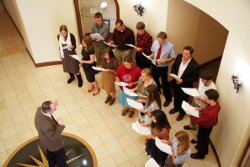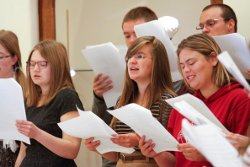- Home
-
About
 Fidelity & Excellence
Fidelity & ExcellenceThomas Aquinas College is unique among American colleges and universities, offering a faithfully Catholic education comprised entirely of the Great Books and classroom discussions.
-
A Liberating Education
 Truth Matters
Truth MattersTruth, and nothing less, sets men free; and because truth is both natural and supernatural, the College’s curriculum aims at both natural and divine wisdom.
-
A Catholic Life
 Under the Light of Faith
Under the Light of FaithThe intellectual tradition and moral teachings of the Catholic Church infuse the whole life of Thomas Aquinas College, illuminating the curriculum and the community alike.
-
Admission & Aid
 Is TAC Right for You?
Is TAC Right for You?Do you enjoy grappling with complex questions? Are you willing to engage in discussions about difficult concepts, with the truth as your ultimate goal?
-
Students & Parents
 Mind, Body & Spirit
Mind, Body & SpiritThere is always something to do at TAC — something worthwhile, something fulfilling, and something geared toward ever-greater spiritual and intellectual growth.
-
Alumni & Careers
 What Can You Do with a Liberal Education?
What Can You Do with a Liberal Education?Nothing speaks more to the versatility of the College’s academic program than the good that our alumni are doing throughout the Church and the world.
- Search
- Giving
Audio: Junior Music Tutorial, Spring 2014
This was not a performance of the Thomas Aquinas College Choir. Indeed, many of the students have little or no choral experience. As members of the College’s junior class, the singers are students in the music tutorial that is required in the third year of the College’s integrated academic program. Students in the tutorial study music’s inner mathematical structure and learn how to read music.The emphasis on singing, with the public performance at the end of the semester, is a new phenomenon, the inspiration of Dr. Phillip Wodzinski, a tutor on the College’s teaching faculty. After his first semester teaching the tutorial in the fall 2010, Dr. Wodzinski was eager to showcase his students’ achievements; so he arranged for the mid-afternoon performance in the College’s faculty and administration building — surprising and delighting passersby.
Below are audio clips of the juniors’ five end-of-the-year hymns, accompanied by Dr. Wodzinski’s description of each one. (Note: To download a clip, click on the down arrow in the audio player.)
“O Master, it is good to be”
1. The students begin with a hymn learned last fall, such a great piece of music that it must be done again: “O Master, it is good to be,” by Arthur Penrhyn Stanley (1815-81), reflects on the glory of the Transfiguration and is well set in music that, while largely in A minor key, is itself glorious. The tune, identified in the 1906 English Hymnal as “Tallis’ Lamentation,” is not related to the famous Lamentations of Jeremiah by Thomas Tallis (1505-85). Instead, it appeared in John Day’s 1562 Psalter, as a setting for “O Lord in Thee is all my trust.” Here, in an arrangement by Ralph Vaughan Williams (1872-1958), the sopranos sing the line written for tenors in the original composition, while the tenors are given a new part; the music begins in D-minor, moves to F-major, then to A-minor, makes a beautiful cadence to an A-major chord, and then returns to D-minor at the end. Lyrics:
[1] O Master, it is good to be high on the mountain here with Thee;
Where stand revealed to mortal gaze the great old saints of other days;
Who once received on Horeb’s height the’ternal laws of truth and right;
Or caught the still small whisper higher than storm, than earthquake, or than fire.
[2] O Master, it is good to be with Thee, and with Thy faithful three:
Here, where th’apostle’s heart of rock is nerved against temptation’s shock;
Here, where the son of thunder learns the thought that breathes, and word that burns;
Here, where on eagle wings we move with him whose last best creed is love.
[3] O Master, it is good to be here on the holy mount with Thee:
When darkling in the depths of night, when dazzled with excess of light,
We bow before the heav’nly voice that bids bewildered souls rejoice,
Though love wax cold, and faith be dim, “This is My Son! O hear ye Him.”
““Expend, o Lord””
2. The students follow with another Tallis tune, this one the sixth in his collection of melodies written in various church modes. In the categories of modes currently used (which is not quite the same as Tallis’s categorization), the bulk of this tune is in the Ionian mode with a couple of switches into and out of the mixolydian mode. The overall key of the piece is A-flat. It begins in the Ionian mode of A-flat, while the second phrase switches to the mixolydian mode of D-flat (a change of both key and mode) but is largely comprised of a nearly motionless repetition of VII chords until it concludes with a strong cadence back into the Ionian mode of A-flat. The third phrase, however, keeps the key of A-flat but moves to the mixolydian mode, and this continues for the first bit of the fourth and final phrase, until we return home to the Ionian mode of A-flat; a brief parenthetical subphrase in the middle of phrase four uses the diminished triad of the key of D-flat to remind us of the earlier excursion into the mixolydian mode of D-flat. The hymn, “Expend, o Lord,” is a translation of Psalm 5 by Matthew Parker (1504-75), for which the music was originally composed. The words of plaint and trust are suitably brought out by the subtle shifts of key and mode as well as by several rather difficult time changes. Lyrics:
[1] Expend, O Lord, my paint of word in grief that I do make.
My musing mind recount most kind; give ear for Thine own sake.
O hark my groan, my crying moan, my King, my God Thou art.
Let me not stray, from Thee away, to Thee I pray in heart.
[2] Just will I go: Thy house into, in trust of Thy great grace:
In fear I will do honour still, within that holy place.
O Lord be guide, defend my side, in Thy great righteousness:
Make plain the way: lest I do stray, my foes shall brag the less.
“Why doth the Lord stand off so far?”
3. The words of the third hymn, “Why doth the Lord stand off so far?” are adapted from Psalm 10 by Isaac Watts (1674-1748), one of the greatest English hymnists. In successive stanzas the speaker asks about God’s apparent absence, then asks whether the wicked will not prevail, and finally calls on to God to “arise” and “attend our humble cry.” The relatively simple music brings out this spiritual drama very effectively. The tune, “Bangor” (the significance of whose name has inspired much unresolved debate), is composed by William Tans’ur (1700-83) and has an interesting key structure. It begins and ends in the Aeolian mode of E-flat (i.e. C-minor) but moves to the Aeolian mode of B-flat (i.e. G-minor) before making a somewhat chromatic cadence to the Ionian mode of G (i.e. G-major) then returning to C-minor, and then back to G-minor, and finally wrapping up at C-minor. As a whole, the music is solemn and sad, though it has enough grandeur and life to keep it from being an out-and-out dirge. In some ways it reminds of “O sacred head, sore wounded.” Lyrics:
[1] Why doth the Lord stand off so far? And why conceal His face,
When great calamities appear, And times of deep distress?
[2] Lord, shall the wicked still deride Thy justice and Thy power?
Shall they advance their heads in pride, And still Thy saints devour?
[3] Arise, o God, lift up Thine hand, Attend our humble cry;
No enemy shall dare to stand When God ascends on high.
“Spirit of God, descend upon my heart”
4. The mood brightens considerably with the fourth hymn, “Spirit of God, descend upon my heart,” by George Croly (1780-1860). The hymn is a prayer requesting neither “prophet ecstasies” nor “op’ning skies” but rather “one holy passion filling all my frame” through “the kindling of the heav’n descended Dove.” The music, an original tune by the great Ralph Vaughan Williams (1872-1958), is in a pretty and lilting C-major that shifts to a slightly more insistent G-major, then to a slightly dark D-dorian, until it returns to a lovely and grand C-major. Especially as following the previous hymn, this hymn’s use of the parallel major, as well as a waltzy tempo, provides a calm emotional lift. Lyrics:
[1] Spirit of God, descend upon my heart; Wean it from earth; through all its pulses move;
Stoop to my weakness, mighty as Thou art, And make me love Thee as I ought to love.
[2] I ask no dream, no prophet ecstasies, No sudden rending of the veil of clay,
No angel visitant, no op’ning skies; But take the dimness of my soul away.
[3] Teach me to love Thee as Thine angels love, One holy passion filling all my frame;
The kindling of the heav’n descended Dove, My heart and altar, and Thy Love the flame.
“All praise to Thee, my God, this night”
5. The students conclude with a simplified version of the famous “Tallis Canon.” The hymn, “All praise to Thee, my God, this night,” by Thomas Ken (1637-1711), is among the most celebrated in the English language. The nocturnal theme of the words may seem strange at ten in the morning, but it is lovely nonetheless. The fourth stanza is quite familiar and is usually sung to the hymn tune known as the “Old Hundredth,” but it works quite well here, too. Lyrics:
[1] All praise to Thee, my God, this night, For all the blessings of the light!
Keep me, O keep me, King of kings, Beneath Thine own almighty wings.
[2] Forgive me, Lord, for Thy dear Son, The ill that I this day have done,
That with the world, myself, and Thee, I, ere I sleep, at peace may be.
[3] O may my soul on Thee repose, And with sweet sleep mine eyelids close,
Sleep that may me more vigorous make To serve my God when I awake.
[4] Praise God, from whom all blessings flow; Praise Him, all creatures here below;
Praise Him above, ye heavenly host; Praise Father, Son, and Holy Ghost.




